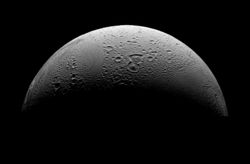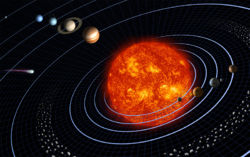Enceladus
 From Conservapedia
From Conservapedia | Enceladus | |
|---|---|
 North pole region of Enceladus, by Cassini | |
| Date of discovery | August 28, 1789[1] |
| Name of discoverer | William Herschel[1][2] |
| Name origin | Giant killed in action in the Titan-Olympian War[1] |
| Orbital characteristics | |
| Primary | Saturn |
| Order from primary | 9 |
| Perikrone | 236,949 km[3] |
| Apokrone | 239,091 km[3] |
| Semi-major axis | 238,020 km[4][5] |
| Orbital eccentricity | 0.0045[4] |
| Sidereal month | 1.370218 da[4] |
| Avg. orbital speed | 12.64 km/s[4] |
| Inclination | 0.00°[4] to Saturn's equator |
| Rotational characteristics | |
| Sidereal day | 1.370218 da[4] |
| Rotational speed | 0.01339 km/s[3] |
| Axial tilt | 0°[4] |
| Physical characteristics | |
| Mass | 1.08 * 1020 kg[4] |
| Density | 1610 kg/m³[4] |
| Mean radius | 252.3 km[6] |
| Equatorial radius | 256 km[4] |
| Polar radius | 245 km[4] |
| Surface gravity | 0.1133 m/s²[3] |
| Escape speed | 0.2391 km/s[3] |
| Surface area | 799,916 km²[3] |
| Mean temperature | 72 K[2] |
| Maximum temperature | 145 K[7] |
| Composition | Water ice, silicates[8] |
| Color | Light blue-white[8] |
| Albedo | 1.0[2][4][9] |
Contents
Discovery and naming[edit]
William Herschel discovered Enceladus on August 28, 1789.[1][10]
Sir John Herschel, his son, suggested the current names of the seven largest satellites of Saturn, including Enceladus. Titan received a generic name, and the other six received names of the Titans of mythology. Enceladus was a giant who fell in battle against Athena in the Titan-Olympian War.[11]
According to legend, Athena buried Enceladus by heaping dirt on him where he fell. His burial mound is supposed to be the island of Sicily, and more specifically he lies beneath Mount Etna, which vents or erupts as he breathes.[1][12] Considering the findings from the exploration of Enceladus by Voyagers 1 and 2 and the Cassini orbiter, Enceladus is a more apt name for this moon than Sir John Herschel might have supposed.
Orbital characteristics[edit]
Enceladus is in a very slightly eccentric orbit around Saturn, at an average distance of 238,020 km,[4][9] or within the most dense region of the E ring of Saturn.[9]
Enceladus might or might not be in a 1:2 orbital resonance with Dione.[9][12][13] The sidereal month of Dione is slightly less than twice that of Enceladus.
Rotational characteristics[edit]
Enceladus is in tidal lock with Saturn. Analysis of 129 images of Enceladus reveals no evidence of any libration, or axial oscillation. However, some astronomers insist that Enceladus must have been in a 1:4 spin/orbit libration in the distant past.[13]
Physical characteristics[edit]
Enceladus has a density of 1.610 kg/m³, 60% greater than that of water. Hence it is likely composed of water ice and rock. With an albedo of unity or greater, Enceladus is the most reflective body in all the solar system.[7]
Surface[edit]
Enceladus has at least five different types of terrain.[2] Regions with impact craters having diameters of 35 km or less, alternate with other regions having no craters. Astronomers suspect extensive remodeling of the surface throughout Enceladus's history.[9]
The most surprising finding is the south polar region. It contains multiple fissures, called "tiger stripes" because their appearance suggests the pelt of a tiger. These fissures radiate significant amounts of heat, with temperatures exceeding 145 K.[7] From these fissures, geysers discharge large amounts of water vapor and ice into space. Some of this remains as a tenuous, localized atmosphere (see below). Other particles escape Enceladus' gravity and thus contribute to the E ring of Saturn.[13][14][15]
Surprisingly, the E ring is not the only ring to receive contributions from Enceladus. Recent evidence now suggests that some of the ejected particles from Enceladus enter Saturn's magnetic field and eventually reach the A ring.[16][17]
Ammonia has not been detected thus far in the discharge.[13] This lack would require liquid water to be as hot as 270 K in order to melt in that environment. (The freezing point of water at one standard atmosphere is 273.15 K.)
Interior[edit]
The interior of Enceladus is perhaps differentiated, with a rocky core and an icy mantle. Nimmo and Pappalardo suggest that some relatively low-density material, either in the core or in the mantle, has protruded to the surface near the south pole. This protrusion might even have caused Enceladus to reorient itself to place this material at the south pole.[18]
Atmosphere[edit]
Enceladus has a thin but significant atmosphere, mostly of water vapor. The chief evidence for this is a deflection of the magnetic field of Saturn as Enceladus moves through it. This atmosphere requires continual replenishment from the cryovolcanic activity.[13][19] In addition, the occultation of the star Bellatrix on July 11, 2005 revealed that the atmosphere is not global in scope, but is probably local to the south polar region, where most of the venting takes place.[20]Magnetosphere[edit]
Enceladus has no detectable magnetic field. However, its atmosphere, such as it is, interferes with Saturn's magnetic field.
Models of the south polar geysers[edit]
Astronomers have considered two possible models for the geysers in the south pole. The "cold geyser model" proposes that the hot rocky core applies heat to pockets of liquid water under tremendous pressure.[13][15] The major difficulty with this model is that the observed temperatures are not high enough to melt pure water, and no ammonia, which would have lowered the melting point, has been detected. Another possibility is that ice on the surface sublimates (changes directly from solid to gas) from the heat. This, however, is inconsistent with the continuous stream of ejected particles now observed.[21]Problems for uniformitarian theories posed by Enceladus[edit]
Enceladus shows many signs of having internal heat, while its inner companion Mimas does not. Yet Enceladus is more distant than Mimas from Saturn, and its orbit is less eccentric. That Mimas should have frozen solid, while Enceladus did not freeze and remains tectonically and volcanically active, defies explanation. Spencer et al[7] have admitted this problem but suggested that forced libration might explain the heating. Yet if Enceladus changed its axis of rotation, as Nimmo and Pappalardo suggested,[18] then the heat must have arisen before the libration.
Observation and Exploration[edit]
Voyager 1 made the first close rendezvous with Enceladus. Project Voyager mission controllers discerned from this encounter that Enceladus was in orbit around Saturn at the thickest portion of the E ring. Voyager 2 revealed the surprising variation in the surface of Enceladus, with geologically "old" and "young" regions.[9]
The Cassini orbiter, early in its mission, returned evidence of the volcanic activity of Enceladus and its possible role as the source of the particulate matter in the E ring.[9] Mission planners then scheduled many more rendezvous with Enceladus. With each encounter, Cassini returned ever more remarkable findings about Enceladus.
The Cassini-Huygens mission is now (June 17, 2008) about to begin its two-year extended mission. This mission will include even more rendezvous with this remarkable object.
Gallery[edit]
References[edit]
- ↑ 1.0 1.1 1.2 1.3 1.4 "Gazetteer of Planetary Nomenclature: Planetary Body Names and Discoverers." US Geological Survey, Jennifer Blue, ed. March 31, 2008. Accessed April 17, 2008.
- ↑ 2.0 2.1 2.2 2.3 Hamilton, Calvin J. "Entry for Enceladus." Views of the Solar System, 2001. Accessed June 17, 2008.
- ↑ 3.0 3.1 3.2 3.3 3.4 3.5 Calculated
- ↑ 4.00 4.01 4.02 4.03 4.04 4.05 4.06 4.07 4.08 4.09 4.10 4.11 4.12 Williams, David R. "Saturnian Satellite Fact Sheet." National Space Science Data Center, NASA, November 23, 2007. Accessed June 4, 2008.
- ↑ "Classic Satellites of the Solar System." Observatorio ARVAL, April 15, 2007. Accessed June 12, 2008.
- ↑ "Planetary Satellite Physical Parameters." Solar System Dynamics, JPL, NASA. Accessed June 17, 2008.
- ↑ 7.0 7.1 7.2 7.3 Spencer, J.R., Pearl, J.C., Segura, M., et al. "Cassini Encounters Enceladus: Background and the Discovery of a South Polar Hot Spot." Science 311(5766):1401-1405, March 10, 2006. doi:10.1126/science.1121661 Accessed June 18, 2008.
- ↑ 8.0 8.1 Hamilton,Calvin J. "A Hot Start Might Explain Geysers on Enceladus." Views of the Solar System, 2007. Accessed June 18, 2008.
- ↑ 9.0 9.1 9.2 9.3 9.4 9.5 9.6 Hubbard, William B. "Enceladus." Encyclopædia Britannica. 2008. Encyclopædia Britannica Online. 18 June 2008.
- ↑ Arrago, M. "Herschel." Annual Report of the Board of Regents of the Smithsonian Institution, 1871, pp. 198-223
- ↑ Lassell, William. "Satellites of Saturn." Monthly Notices of the Royal Astronomical Society, 8(3):42-43, January 14, 1848. Accessed June 4, 2008.
- ↑ 12.0 12.1 Arnett, Bill. "Entry for Enceladus." The
Nine8 Planets, March 30, 2007. Accessed June 17, 2008. - ↑ 13.0 13.1 13.2 13.3 13.4 13.5 Porco, C.C., Helfenstein, P., Thomas, P.C., et al. "Cassini Observes the Active South Pole of Enceladus." Science 311(5766):1393-1401, March 10, 2006. doi:10.1126/science.1123013 Accessed June 18, 2008.
- ↑ Spahn, F., Schmidt, J., Albers N., et al. "Cassini Dust Measurements at Enceladus and Implications for the Origin of the E Ring." Science 311(5766):1416-1418. doi:10.1126/science.1121375 Accessed June 18, 2008.
- ↑ 15.0 15.1 Hamilton, Calvin J. "Radical! Liquid Water on Enceladus." Views of the Solar System, March 9, 2006. Accessed June 18, 2008.
- ↑ Farrell, W.M., Kaiser, M.L., Gurnett, D.A., et al. "Mass unloading along the inner edge of the Enceladus plasma torus." Geophys. Res. Lett. 35(L02203), January 23, 2008. doi:10.1029/2007GL032306 Accessed June 18, 2008.
- ↑ Hamilton, Calvin J. "Saturn's Giant Sponge." Views of the Solar System, February 5, 2008. Accessed June 18, 2008.
- ↑ 18.0 18.1 Nimmo, F., and Pappalardo, R. T. "Diapir-induced reorientation of Saturn's moon Enceladus." Nature 441:614-616, June 1, 2006. doi:10.1038/nature04821 Accessed June 18, 2008.
- ↑ "Cassini Finds an Atmosphere on Saturn's Moon Enceladus." Press release, JPL, March 16, 2005. Accessed June 17, 2008.
- ↑ "Enceladus Atmosphere Not Global." JPL, NASA, August 30, 2005. Accessed June 17, 2008.
- ↑ Hamilton, Calvin J. "Scientists Study 'Plumbing' in Plumes of Enceladus." Views of the Solar System, February 7, 2008. Accessed June 18, 2008.
| |||||||||||||||||||||||||||||
Categories: [Astronomy]
↧ Download as ZWI file | Last modified: 02/08/2023 10:16:33 | 7 views
☰ Source: https://www.conservapedia.com/Enceladus | License: CC BY-SA 3.0
 ZWI signed:
ZWI signed:











 KSF
KSF